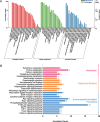Comparative analyses of long non-coding RNA in lean and obese pig
- PMID: 28589911
- PMCID: PMC5522191
- DOI: 10.18632/oncotarget.18269
Comparative analyses of long non-coding RNA in lean and obese pig
Abstract
Objectives: Current studies have revealed that long non-coding RNA plays a crucial role in fat metabolism. However, the difference of lncRNA between lean (Duroc) and obese (Luchuan) pig remain undefined. Here, we investigated the expressional profile of lncRNA in these two pigs and discussed the relationship between lncRNA and fat deposition.
Materials and methods: The Chinese Luchuan pig has a dramatic differences in backfat thickness as compared with Duroc pig. In this study, 4868 lncRNA transcripts (including 3235 novel transcripts) were identified. We determined that patterns of differently expressed lncRNAs and mRNAs are strongly tissue-specific. The differentially expressed lncRNAs in adipose tissue have 794 potential target genes, which are involved in adipocytokine signaling pathways, the PI3k-Akt signaling pathway, and calcium signaling pathways. In addition, differentially expressed lncRNAs were located to 13 adipose-related quantitative trait loci which include 65 QTL_ID. Subsequently, lncRNA and mRNA in the same QTL_ID were analyzed and their co-expression in two QTL_ID were confirmed by qPCR.
Conclusions: Our study provides an insight into mechanism behind the fat metabolic differences between the two breeds and lays an important groundwork for further research regarding the regulatory role of lncRNA in obesity development.
Keywords: QTL; lncRNA; obesity; pig.
Conflict of interest statement
The authors have declared that no competing interests exist.
Figures






Similar articles
-
Identification and comparison of long non-conding RNA in Jinhua and Landrace pigs.Biochem Biophys Res Commun. 2018 Nov 30;506(3):765-771. doi: 10.1016/j.bbrc.2018.06.028. Epub 2018 Jun 23. Biochem Biophys Res Commun. 2018. PMID: 29890140
-
Transcriptome analysis to identify long non coding RNA (lncRNA) and characterize their functional role in back fat tissue of pig.Gene. 2019 Jun 30;703:71-82. doi: 10.1016/j.gene.2019.04.014. Epub 2019 Apr 5. Gene. 2019. PMID: 30954676
-
Genome-Wide Analysis of mRNAs and lncRNAs of Intramuscular Fat Related to Lipid Metabolism in Two Pig Breeds.Cell Physiol Biochem. 2018;50(6):2406-2422. doi: 10.1159/000495101. Epub 2018 Nov 13. Cell Physiol Biochem. 2018. PMID: 30423578
-
The role of long noncoding RNA in lipid, cholesterol, and glucose metabolism and treatment of obesity syndrome.Med Res Rev. 2021 May;41(3):1751-1774. doi: 10.1002/med.21775. Epub 2020 Dec 24. Med Res Rev. 2021. PMID: 33368430 Review.
-
[Role of miRNA and lncRNA in animal fat deposition-a review].Sheng Wu Gong Cheng Xue Bao. 2020 Aug 25;36(8):1504-1514. doi: 10.13345/j.cjb.200232. Sheng Wu Gong Cheng Xue Bao. 2020. PMID: 32924349 Review. Chinese.
Cited by
-
Identification of circRNAs Associated with Adipogenesis Based on RNA-seq Data in Pigs.Genes (Basel). 2022 Nov 7;13(11):2062. doi: 10.3390/genes13112062. Genes (Basel). 2022. PMID: 36360299 Free PMC article.
-
The role of long non-coding RNAs in the development of adipose cells.Noncoding RNA Res. 2023 Mar 2;8(2):255-262. doi: 10.1016/j.ncrna.2023.02.009. eCollection 2023 Jun. Noncoding RNA Res. 2023. PMID: 36890808 Free PMC article. Review.
-
Analyzing the interactions of mRNAs, miRNAs and lncRNAs to predict ceRNA networks in bovine cystic follicular granulosa cells.Front Vet Sci. 2022 Oct 13;9:1028867. doi: 10.3389/fvets.2022.1028867. eCollection 2022. Front Vet Sci. 2022. PMID: 36311668 Free PMC article.
-
Genomic analysis reveals genes affecting distinct phenotypes among different Chinese and western pig breeds.Sci Rep. 2018 Sep 6;8(1):13352. doi: 10.1038/s41598-018-31802-x. Sci Rep. 2018. PMID: 30190566 Free PMC article.
-
Genome-wide identification and characterization of novel long non-coding RNA in Ruminal tissue affected with sub-acute Ruminal acidosis from Holstein cattle.Vet Res Commun. 2020 Feb;44(1):19-27. doi: 10.1007/s11259-020-09769-w. Epub 2020 Feb 11. Vet Res Commun. 2020. PMID: 32043213
References
Publication types
MeSH terms
Substances
LinkOut - more resources
Full Text Sources
Other Literature Sources
Medical

